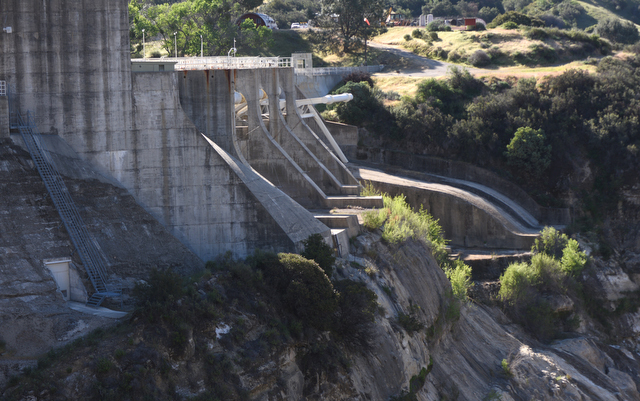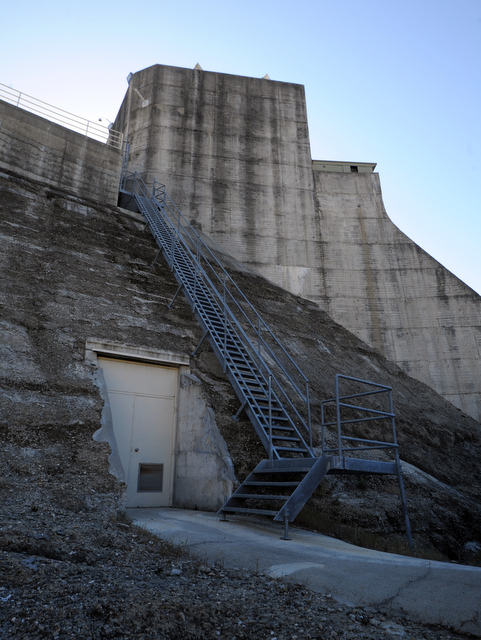Wetter and Better, but Drought’s Far from Over
Gibraltar Reservoir Poses Serious Water Quality Problems

Choirs of frogs can now be heard singing in South Coast creeks, a sonic manifestation of the heavier than average rainfall gracing Santa Barbara’s South Coast. The good news is that the City of Santa Barbara’s Gibraltar Reservoir spilled last week and remains full, and the amount of water in Lake Cachuma has doubled since the New Year.
But every silver lining, it seems, comes equipped with a discouraging storm cloud. In this case, none of the 23,500 acre-feet of water pooling in Lake Cachuma qualifies as what the experts call “project water,” meaning it’s not available for human consumption by South Coast water agencies. (Not until there’s a live stream running immediately from the base of the dam to the mouth of the Santa Ynez River can water agencies draw from what’s in Cachuma.)

Because Gibraltar has been so choked with ash-encrusted dirt and debris, generated by the recent Rey Fire, it poses serious water quality problems. City of Santa Barbara water czar Joshua Haggmark estimated Gibraltar’s water quality challenges exceed the city’s technical capacity to treat the water to potable standards by a factor of two.
With snow pack statewide the deepest it’s been in 22 years, half of California’s land mass has escaped the clutches of the drought. Last year at this time, 95 percent of the state met one of the many gradations of drought designation. The southern portion of Santa Barbara County not only remains very much in drought, but it remains in the throes of what’s defined as a severe or extreme drought. Less than two percent of the state’s acreage is so defined. As a result, Haggmark said Santa Barbara residents need to keep pushing to meet or exceed the city’s 35 percent conservation targets.
Thus far, there’s no push to rescind the outdoor watering ban that went into effect this January. But with the sustained precipitation, the impetus for outdoor irrigation has diminished greatly. Haggmark said he’ll have a better sense of what adjustments, if any, are appropriate in March.
With so much of the state out of the drought, the Department of Water Resources is expected to announce an increase in state water deliveries. Currently, deliveries are pegged at 60 percent of total contract allocations. Depending on which rumors one subscribes to, that could jump to 80 percent or perhaps even 100. Should the latter transpire, that would be historic.
Giving local water officials’ serious heartburn is the fate of 30,000 acre-feet of state water — from previous years — that’s been banked in the San Luis Reservoir, the fifth largest in the state. State water managers predict that the reservoir will “spill” February 15. If and when that occurs, any water banked there by other water agencies will be lost.
For the past two weeks, South Coast water officials have been scrambling to secure alternate storage space for that water. Given the constraints of pipeline size, South Coast water agencies can’t get any more than 49 acre-feet a day through the network of pipes and pumps that make up its connection to the state water system. Thursday afternoon, Ray Stokes of the Central Coast Water Authority signed an agreement with the Metropolitan Water District (MWD) in Los Angeles, which has the physical capacity to move vast quantities of water.
Under this deal, MWD has agreed to move a big chunk of the water stored in San Luis by South Coast water agencies but only after it’s rescued its own water. In other words, there’s no guarantee MWD can get the South Coast water by February 15. “We may get our water out with the Metropolitan Water District or we may not,” explained Ray Stokes. “But for an absolute fact we know if we leave the water in San Luis we will lose it.”
In the meantime, the Montecito Water District and the City of Santa Barbara have continued negotiations so that Montecito can draw on desalinated water produced by the city’s new and improved desalt plant, scheduled to begin production sometime this March. No final agreement has been reached, but the terms of the contract appear to have been established. Those must be ratified by the respective decision makers in the weeks ahead.
Any deal with Montecito will require a significant increase in the production capacity of the plant and the installation of the pipes to convey the water to Montecito customers. When originally discussed as a possible water supply three years ago, the desal plant improvements weighed in at $18 million. Today, they’re hovering at $70 million. As far as additional rains this year, that remains anybody’s guess. According to the latest weather forecasts, there’s an equal chance for above-normal precipitation as there is for below-average rainfall.



